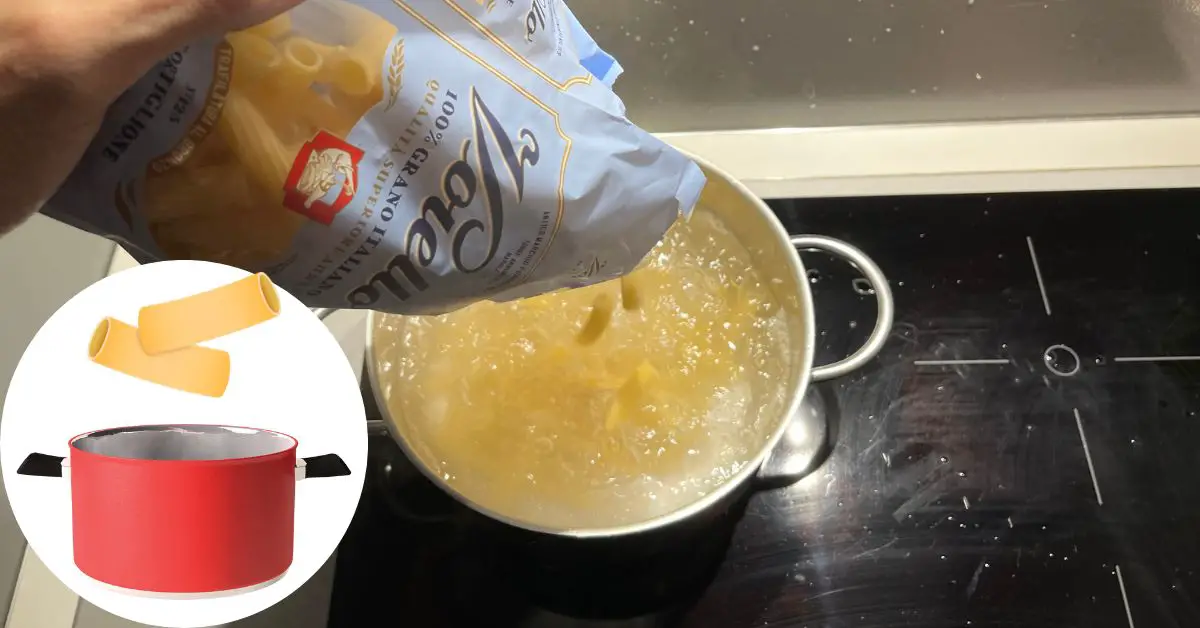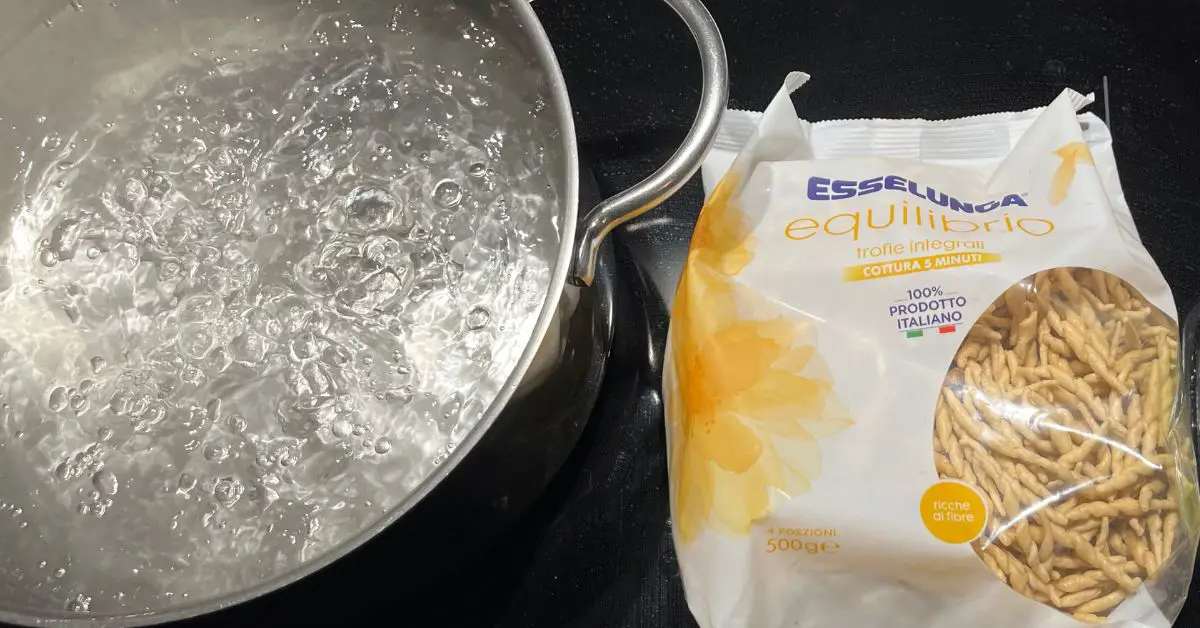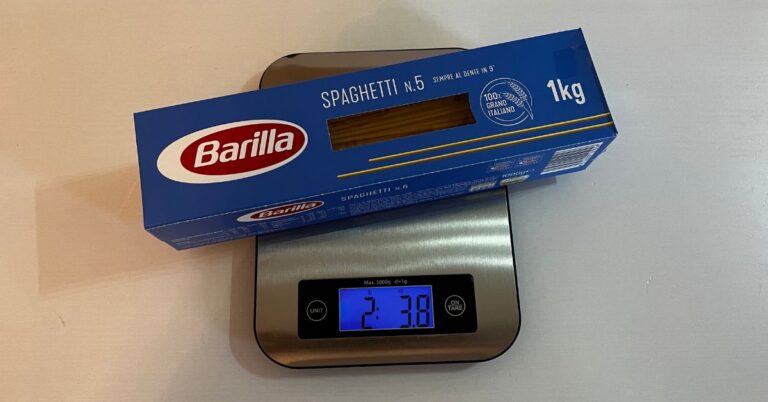Today we will find out if and how Italians really practice and appreciate “passive cooking technique” of pasta and why it is so important at this moment in history.
But first, let’s see exactly what this technique consists of and how to apply it to achieve “al dente” pasta cooking.
Here in Italy cooking pasta “al dente”, i.e. not overcooked and maintaining a degree of internal hardness without becoming excessively sticky, is always the priority to achieve a good pasta dish, here I explained how to obtain a perfect pasta with classic cooking, while below you will see the passive cooking.
How to cook pasta al dente with passive cooking
Passive cooking of pasta is an alternative method of cooking pasta that saves energy and reduces CO₂e emissions by up to 80%, by simply boiling the pasta for 2 minutes on high heat and then turning the stove off and letting the pasta cook in the hot water, taking care to cover the pot with a lid for the recommended time
In Italy it is also known as “cooking with the stove off” and counts of 6 preparation steps.
How to cook al dente pasta with Passive Cooking
Total Time: 15 minutes
Boil water
Boil water in a pot suitable to hold 1 liter of water for every 100 grams of pasta.
Salt the water
Add the salt: 10 grams (0.4 oz or 1/8 cup) of salt per liter of water and 100 grams of dry pasta are recommended. If you are in doubt about which type of salt to use, click on the link.
Toss the pasta
When the water boils, throw in the amount of pasta according to the number of diners. Do you want to know how much pasta per person, click the link.
Turn to passive cooking
After two minutes of active cooking with the stove on, turn off the stove, and thus passive cooking begins.
Use a lid and wait
Cover the pot with a lid and wait for the proper cooking time to finish cooking and get the pasta al dente (read below for specific cooking time).
Drain the pasta and season it
Drain the pasta, season it with the sauce of your choice and serve it on plates. Now the pasta is ready to be enjoyed.
As with the standard pasta cooking methods, it is important to follow the correct timing, even more so if you want to enjoy an “al dente” pasta dish, in fact, with passive cooking, it is even easier to get the cooking times wrong and overcook your pasta.
The main difficulty is due to the double cooking time, first active cooking with the stove on and then passive cooking with the stove off; it is precisely the latter that hides the biggest pitfalls, as it determines whether the pasta will be cooked al dente or “scotta” i.e. not al dente.
In case you don’t know, it’s really important to always cook pasta al dente, and never overcook it.
Below you can find a table with the average passive cooking times, active and passive timing indicated, of the most popular pasta shapes. If possible, however, try to rely on the cooking information found on the pasta package.
Italian Pasta with Passive Cooking Technique
Equipment
- 1 Stock Pot with Lid
- Colander
- Ladle
- Timer
Ingredients
- coarse salt
- 500 grams dry pasta
Instructions
- Boil waterBoil water in a pot suitable to hold 1 liter of water for every 100 grams of pasta.

- Salt the waterAdd the salt: 10 grams (0.4 oz or 1/8 cup) of coarse salt per liter of water and 100 grams of dry pasta are recommended. If you are in doubt about which type of salt to use, click on the link.

- Toss the pastaWhen the water boils, throw in the amount of pasta according to the number of diners. I normally toss 500 grams dry pasta. Do you want to know how much pasta per person, click the link.

- Turn to passive cookingAfter two minutes of active cooking with the stove on, turn off the stove, and thus passive cooking begins.

- Use a lid and waitCover the pot with a lid and wait for the proper cooking time to finish cooking and get the pasta al dente (read below for specific cooking time).

- Drain the pasta and season itDrain the pasta, season it with the sauce of your choice and serve it on plates. Now the pasta is ready to be enjoyed.

Notes
Passive Cooking Timing Guide for different pasta shapes.
In this table below you can see the pasta shape and its standard cooking time, i.e., on the stove always on, and the passive cooking time, which is always made up of 2 minutes of active cooking with the stove on plus “X” minutes of passive cooking with the stove off, with the lid on the pot.
| Pasta shape | Minutes of traditional cooking | Minutes of Passive Cooking |
| Bucatini | 8 min. | 2+8 min. |
| Cappellini | 3 min. | 2+1 min. |
| Coquillettes | 7 min. | 2+6 min. |
| Farfalle | 10 min. | 2+10 min. |
| Fusilli | 11 min. | 2+10 min. |
| Gemelli | 10 min. | 2+9 min. |
| Girandole | 11 min. | 2+11 min. |
| Gobbetti | 11 min. | 2+10 min. |
| Maccheroni | 7 min. | 2+6 min. |
| Penne Rigate | 11 min. | 2+10 min. |
| Pipe Rigate | 10 min. | 2+10 min. |
| Spaghetti | 9 min. | 2+8 min. |
| Spaghettini | 5 min. | 2+4 min. |
| Spaghettoni | 11 min. | 2+10 min. |
| Tortiglioni | 12 min. | 2+12 min. |
Passive cooking is also much talked about in Italy, as this technique brings with it benefits in terms of economics and environmental sustainability, but are Italians willing to risk cooking pasta that is not al dente to save on their bills? Let’s find out!
Do Italians use passive cooking to cook pasta at home?
Few Italians adopt passive cooking because it is difficult to change such well-established habits in a country like Italy, where pasta is the star of home cooking.
According to research conducted by the Italian pasta makers of Unione Italiana Food, passive cooking is adopted by only one in ten Italians.
However, there is a growing awareness of the positive effects on the environmental impact of certain cooking behaviors. In fact, healthy habits such as using less water and always putting the lid on the pot to reach boiling point sooner have taken hold.
When did passive cooking originate and why is everyone talking about it now?
Passive cooking is a technique that dates back to the mid-1800s, but it has only been catching on in recent years because of the increased concern for the environment.
The energy crisis of this period has certainly helped bring it into the limelight. It is, in fact, an alternative method of cooking pasta that saves energy and reduces carbon dioxide emissions by up to 80 %.
The benefits were highlighted by physics Nobel Giorgio Parisi, who highlighted this method of cooking pasta, polluting less and saving on gas.
Why did some Italians consider it heresy to cook pasta with the heat off?
Passive Cooking collides with a highly rooted gastronomic culture, where pasta is the queen, this innovation is not seen well by everyone here.
Many Italians say that in terms of taste, the result is mediocre. For example, chef Antonello Colonna stated that pasta cooked with passive cooking is likely to take on a rubbery and unpleasant texture.
Moreover, not all Italians perceive the real savings from passive cooking to be both real and relevant. Despite it would seem that the savings are not to be underestimated at all, especially in this time of energy crisis.
According to the Italian pasta makers of Unione Italiana Food, passive cooking would lead to energy and carbon dioxide emission savings of up to 47 % compared to the traditional method
Pros and Cons of Passive Cooking
Pros of passive cooking of pasta:
- Energy and economic savings, in terms of gas by at least 10 minutes and 80% less CO2 emissions.
- Taste and texture seem to improve, pasta tends not to break up because it does not have to be stirred, and also, it can hold the sauce better due to the presence of more starch on the surface.
Cons of passive cooking of pasta:
- More difficult to achieve al dente pasta, as the cooking times listed on pasta packages refer to traditional cooking.
- Is slower cooking; some pasta shapes require about 2 minutes more cooking time with the passive technique.
- The pasta is likely to be more viscous and sticky, a taste that should diminish thanks to the seasoning.
Is passive cooking faster or slower than traditional cooking?
Some types of pasta respond to passive cooking in the same way, and the cooking time does not change. But for many other types, passive cooking takes at most a couple of minutes longer than traditional cooking.
Al dente pasta: is it easier or harder to achieve with passive cooking?
For those who like their pasta very “al dente”, it is preferable to opt for traditional cooking. The passive cooking method is hardly suitable for those who like al dente pasta, unless you are very good with time management.
Are there accessories for passive cooking of pasta?
The basic accessories for passive cooking are:
- pot with a lid,
- a stopwatch or simple clock to check cooking minutes.
These two things are enough to do passive cooking; if you do not have a lid for your pasta pot, know that you can use a large plate to place over the pot to replace the lid and achieve the same result.
Barilla, a leading Italian multinational dry pasta company, has come up with the first smart device for passive cooking.
It is the Passive Cooker, which associates with the smartphone, thanks to a dedicated app, applies to any type of lid and alerts when the water boils, simplifying time management.
As we have seen, passive cooking of pasta with the heat off is developing in Italy, despite the strong tradition that accompanies pasta. It is believed that the commitment to the environment and energy conservation will also come through the kitchen, at least in the medium term.








